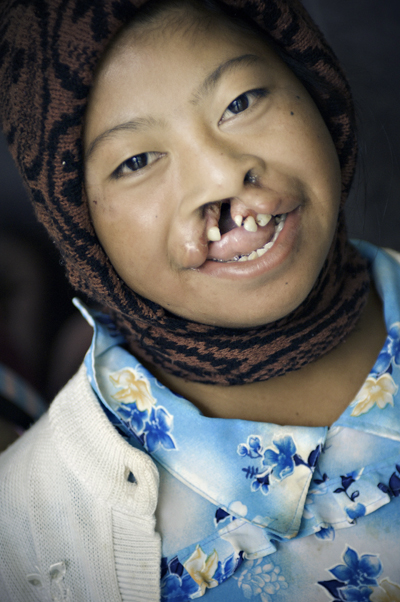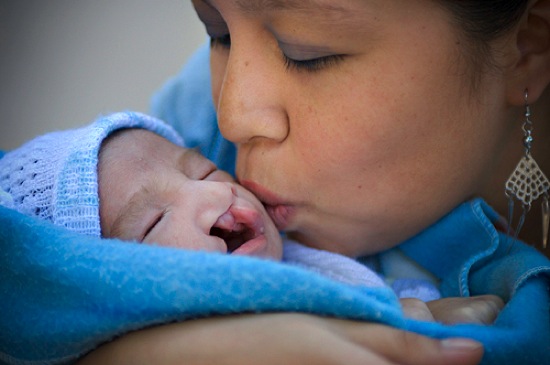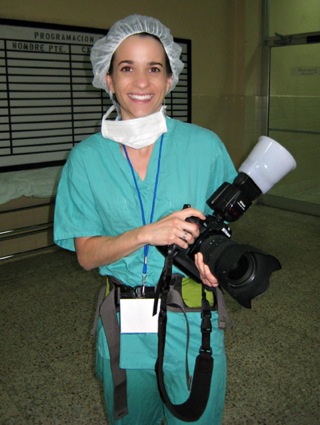by Angela Weedon, Angela Weedon Photography, Garland, Texas
March 2007 Operation Smile mission to Honduras
A child I love was born with a cleft lip. I will never forget the shock of seeing my nephew’s deformity in his first hours of life. Thankfully, the concern quickly wore off. After all, we lived in America, my brother had insurance, and my nephew could eat just fine. He would have no problems: Simply wait three months, have reconstructive plastic surgery, and it would be water under the bridge. The only reminder of Conner’s deformity today, seven years later, is a tiny scar, and we have to closely study his little mouth to even see it.

Had my nephew been born in a developing country, however, his story likely would have been much different. In many parts of the world, children born with cleft lips or palates–or a combination of the two–can suffer lifetimes of hardships, from malnutrition due to feeding difficulties, to severe speech problems, to being completely ostracized by the community.
 After Conner was born, I did a lot of research on the subject of clefts. The more I learned, the more I was thankful for all the resources we have, which perhaps we take for granted. So Operation Smile naturally has been close to the hearts of my family for years. This amazing organization sends qualified doctors, nurses and support personnel to dozens of developing countries around the world with the sole purpose of bringing smiles to children who need them. Since 1982, in addition to performing surgeries on more than 100,000 deserving children and young adults, Operation Smile volunteers also have trained thousands of healthcare professionals globally. For only $240, they can change a child’s life by giving the gift of a cleft lip surgery. Knowing all this, we supported Operation Smile as a family. But never dreamed I would one day witness a mission first-hand.
After Conner was born, I did a lot of research on the subject of clefts. The more I learned, the more I was thankful for all the resources we have, which perhaps we take for granted. So Operation Smile naturally has been close to the hearts of my family for years. This amazing organization sends qualified doctors, nurses and support personnel to dozens of developing countries around the world with the sole purpose of bringing smiles to children who need them. Since 1982, in addition to performing surgeries on more than 100,000 deserving children and young adults, Operation Smile volunteers also have trained thousands of healthcare professionals globally. For only $240, they can change a child’s life by giving the gift of a cleft lip surgery. Knowing all this, we supported Operation Smile as a family. But never dreamed I would one day witness a mission first-hand.
After being the largest contributor to the 2005 and 2006 PPA Charities Family Portrait Month promotions, I received the chance to join an Operation Smile medical mission team. The roughly 50 volunteers on the Honduras Mission in March 2007 welcomed me with open arms and allowed me to document their amazing work. The volunteers from around the world included plastic surgeons, pediatricians, anesthesiologist, dentists, speech therapists, nurses, medical record specialists, translators, patient imaging technicians, and a wonderful support staff of Honduran volunteers. It was simply overwhelming to see all of these people give of their valuable time and talents for such a hard, yet rewarding, cause.
We were all there for the kids–and they were amazing. Some families traveled for days for the chance to have their child’s deformity repaired, and many were hungry when they arrived. Seeing the long line of families waiting patiently to have their children medically screened on the first day was very powerful. I couldn’t help but think about my own two kids: How would they behave? How would I cope, with little food and no change of diaper for the baby. No bag of snacks and toys and coloring books for my three-year-old. As the cold chill in the early morning hours turned to searing midday heat, the line crept slowly along.
 I thought surely these kids would fuss; but amazingly, they did not. They waited, they played with one another, and they laughed along with the Operation Smile volunteers, who handed out small dollar store trinkets and sidewalk chalk. I arrived thinking that I would be taking sad pictures of deformed children, but they really taught me a lesson: It was an eye-opener to see such joy from children we are conditioned to pity.
I thought surely these kids would fuss; but amazingly, they did not. They waited, they played with one another, and they laughed along with the Operation Smile volunteers, who handed out small dollar store trinkets and sidewalk chalk. I arrived thinking that I would be taking sad pictures of deformed children, but they really taught me a lesson: It was an eye-opener to see such joy from children we are conditioned to pity.
I was charged with photographing the mission from start to finish, and on that first day, I felt overwhelmed. There were many children with obvious deformities, and even more were there for follow-up surgeries to repair cleft palates that remained after lip surgeries done by Operation Smile on a previous mission. The job of screening them all and deciding who were surgical candidates was difficult for the entire team. After two days of screening, long lines, and heat, the patient list had been made, and surgery week would start after the weekend.
 I was charged with photographing the mission from start to finish, and on that first day, I felt overwhelmed. There were many children with obvious deformities, and even more were there for follow-up surgeries to repair cleft palates that remained after lip surgeries done by Operation Smile on a previous mission. The job of screening them all and deciding who were surgical candidates was difficult for the entire team. After two days of screening, long lines, and heat, the patient list had been made, and surgery week would start after the weekend.
I was charged with photographing the mission from start to finish, and on that first day, I felt overwhelmed. There were many children with obvious deformities, and even more were there for follow-up surgeries to repair cleft palates that remained after lip surgeries done by Operation Smile on a previous mission. The job of screening them all and deciding who were surgical candidates was difficult for the entire team. After two days of screening, long lines, and heat, the patient list had been made, and surgery week would start after the weekend.
The team stayed in a hotel in Tegucigalpa, and the Honduran volunteers treated us to a wonderful weekend. We had team meetings to get to know one another, went to fun dinners around town, and went sightseeing in a village outside the city. We also visited a hacienda in the countryside for a delicious cookout and swimming in the pool. Some of us learned to salsa dance and drank a few cervezas.
While the weekend was like a vacation, the 5:30 a.m. wake-up call on Monday morning (and everymorning thereafter) brought us back to reality. After breakfast at the hotel and a 6 a.m. team meeting, we were off to the hospital. The building

was not what I expected. During the first few days there, I couldn’t grasp how such a place could possibly be a hospital, but I came to recognize that the people were doing their best with what they had. It deepened my appreciation of just how much we have here in our own country.
Approximately 15 to 20 surgeries were scheduled per day. This meant that the doctors and nurses worked from morning till night for five straight days to repair the smiles of these precious children. Some babies were as young as two months old, while other kids were as old as 14 years. Most
days, I floated from pre-op–a large, dormitory-style room where the patients and one of their parents would stay the night before surgery–to the Child Life area. Here the kids waited for an hour or two to do play therapy games and relax before going to surgery. I spent a lot of time in there, just building blocks, doing puzzles, and blowing bubbles with kids who, perhaps, had never done these things before. Most were content and ready for surgery when the doctor came to take them to the operating room.
It was an honor to be welcomed into the operating room to see how these doctors began to transform the children’s lives. I stayed at the head of each table and photographed all that I saw, from the surgeons’ hands floating above the children’s mouths in the bright operating room light, to the anesthesiologists monitoring the equipment, to the nurses assisting with the instruments. After surgery, I followed the patients to the recovery room where their parents got to see them for the first time. Most moms wept tears of joy when they saw their children, a stark contrast to the fear and worry they felt moments earlier in the corridor outside the operating room.
 After spending a few hours in the recovery room, the patients were moved to post-op. This was another dormitory-style hospital room where all the day’s patients would spend the night under the watchful eye of Operation Smile volunteer nurses and pediatricians. It was very hard to photograph in here for obvious reasons. Most kids had considerable swelling and were groggy, but I could hold the hands of some of the moms and learn a little more about the stories that brought them there. Parents were taught how to care for their children, how to clean the incisions, what to feed them, and how to administer the pain reliever. They were also counseled by speech therapists, so they could help their kids learn how to speak with their repaired cleft palate. The next morning, the patients were discharged, and the process would begin again. And so would I.
After spending a few hours in the recovery room, the patients were moved to post-op. This was another dormitory-style hospital room where all the day’s patients would spend the night under the watchful eye of Operation Smile volunteer nurses and pediatricians. It was very hard to photograph in here for obvious reasons. Most kids had considerable swelling and were groggy, but I could hold the hands of some of the moms and learn a little more about the stories that brought them there. Parents were taught how to care for their children, how to clean the incisions, what to feed them, and how to administer the pain reliever. They were also counseled by speech therapists, so they could help their kids learn how to speak with their repaired cleft palate. The next morning, the patients were discharged, and the process would begin again. And so would I.
 Operation Smile conducts post-op follow-up one week after surgery for the patients. One day, the First Lady of Honduras came to tour the mission, and on another, the U.S. Ambassador to Honduras visited. There was plenty to see and photograph each day, and by the end of the week, I had thousands of images to organize.
Operation Smile conducts post-op follow-up one week after surgery for the patients. One day, the First Lady of Honduras came to tour the mission, and on another, the U.S. Ambassador to Honduras visited. There was plenty to see and photograph each day, and by the end of the week, I had thousands of images to organize.
I produced a DVD slideshow of the mission that was shown at our final night party. With tears streaming down many of the volunteers’ faces, I knew that none of our lives would be the same again. More than 100 little lives were changed for the better, all due to the selfless donation of time, talent, and funds to Operation Smile. And while many of these kids found considerable joy in their lives when we might not expect them to, I can only imagine how much they are smiling now. But now, it is my turn to smile as again I am honored to dedicate our studio’s fundraising to Operation Smile.
